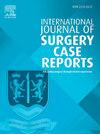Management and functional outcomes of a pipkin type II fracture: A case report
IF 0.6
Q4 SURGERY
引用次数: 0
Abstract
Introduction
Femoral head (Pipkin) fractures are rare injuries typically caused by high-energy trauma. Classified into four types, their management remains debated, particularly for Pipkin type II fractures. This case report provides insights into surgical treatment, rehabilitation, and associated complications.
Case presentation
A 22-year-old male sustained a Pipkin type II femoral head fracture from a dashboard injury in a car accident. He presented with a posterior hip dislocation and a fracture involving the weight-bearing surface. Closed reduction was performed within 40 min, followed by open reduction and internal fixation (ORIF) using two Herbert screws via an anterior approach. The patient was discharged after three days and began structured rehabilitation. At six months, he showed significant functional recovery with minimal restrictions.
Discussion
The management of Pipkin type II fractures remains controversial, particularly regarding fragment fixation versus excision. Early surgical intervention and stable fixation are key to reducing complications such as avascular necrosis (AVN) and post-traumatic arthritis. In this case, ORIF with early rehabilitation, including gradual weight-bearing and range of motion exercises, contributed to a favorable outcome.
Conclusion
Prompt surgical intervention and a structured rehabilitation program are essential for optimal recovery in Pipkin type II fractures. This case highlights the importance of individualized treatment strategies and adds to the growing literature on managing this rare injury.
求助全文
约1分钟内获得全文
求助全文
来源期刊
CiteScore
1.10
自引率
0.00%
发文量
1116
审稿时长
46 days

 求助内容:
求助内容: 应助结果提醒方式:
应助结果提醒方式:


